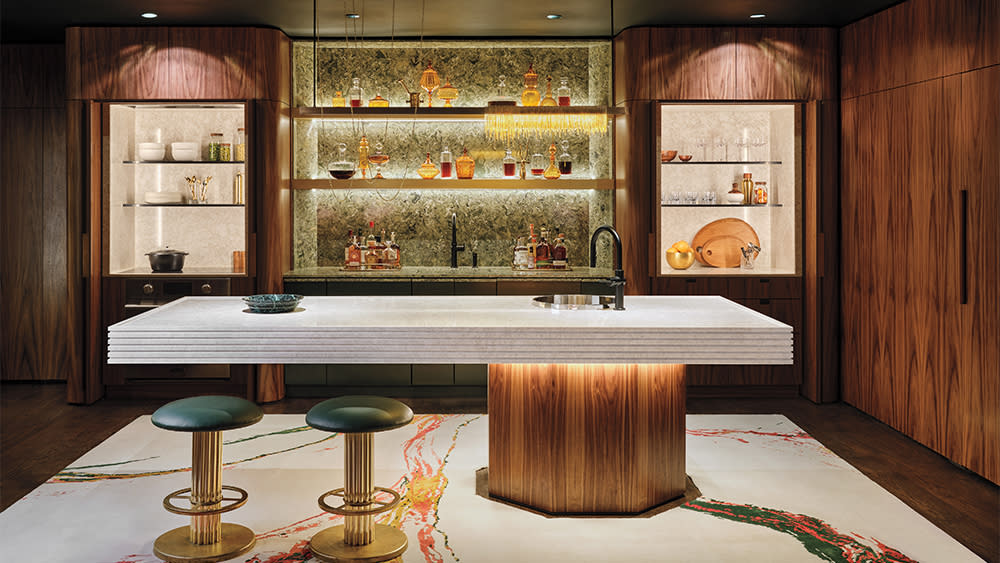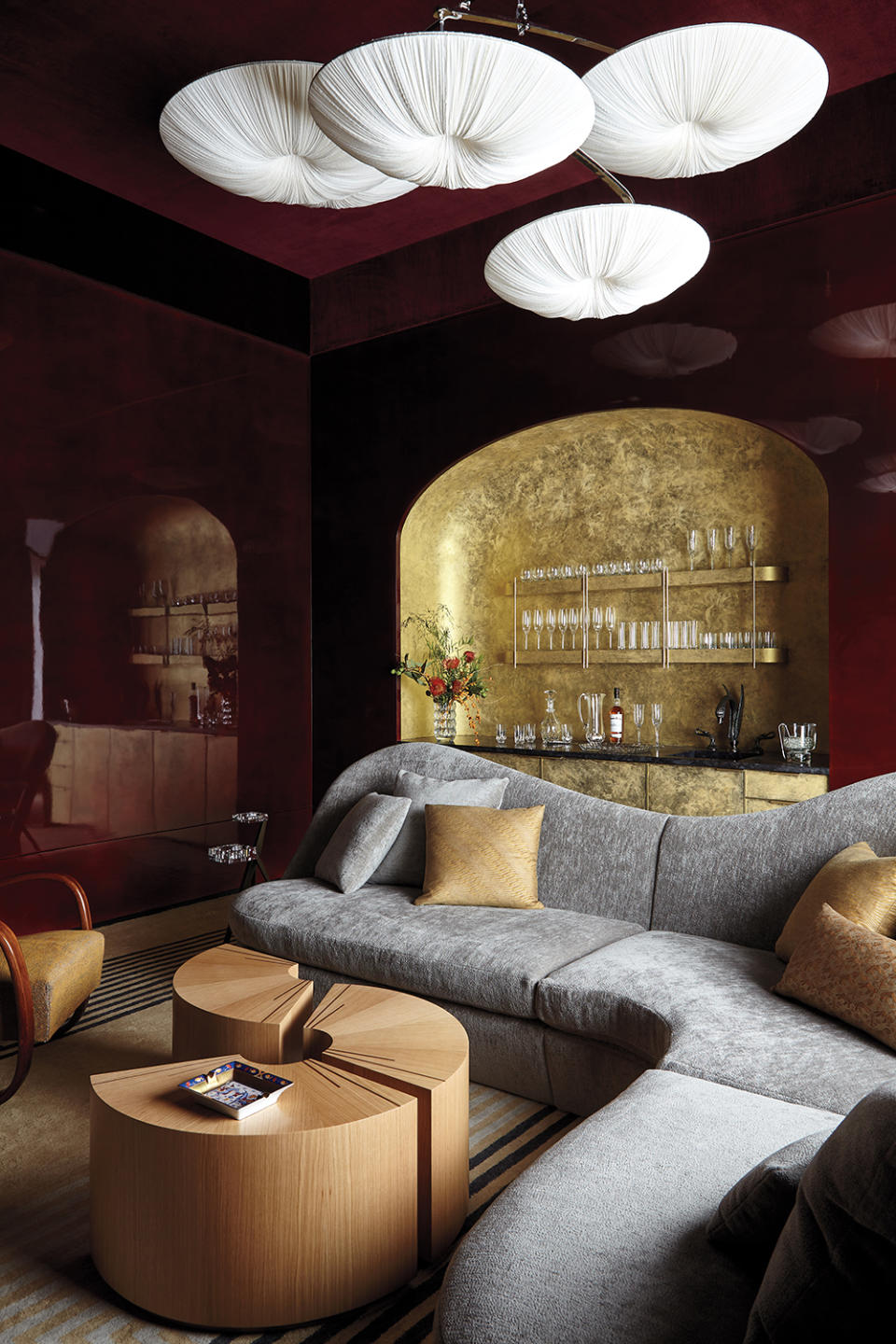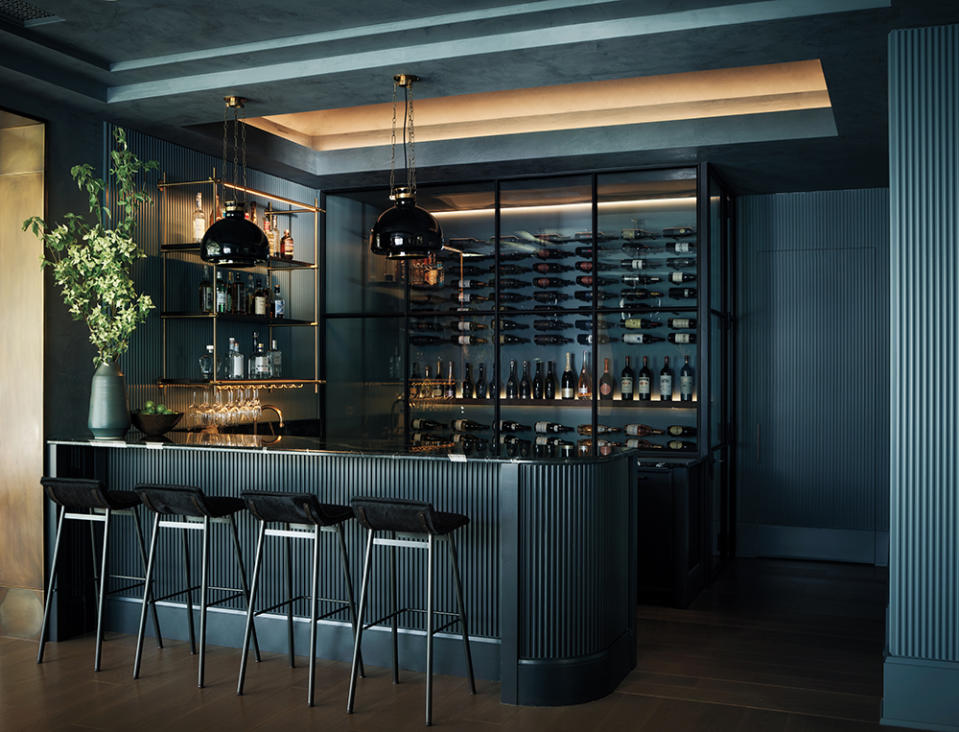Lavish In-Home Bars Are Becoming the New Luxury Must-Have

Staying in is the new going out, so why not up the ante with an in-home bar to rival your favorite neighborhood watering hole? Having your own lounge or speakeasy means you get to choose the music and mood (no more overplayed songs or over-served strangers to kill the vibe), and if the party’s going strong, there’s no racing against the clock to make the most of your night. For many, a standard rolling cart is a good entry point, but if you’re a die-hard home mixologist, fancy yourself an entertaining aficionado, or just want the option to enjoy a cocktail in private luxury, leveling up with a dedicated, built-in space is the next logical step. And according to designers across the country, there has been an uptick in this type of request.
“We’re now putting bars in about 80 percent of our projects,” says Caitlin Jones Ghajar of Seattle-and-San-Francisco-based Caitlin Jones Design, who recently completed a moody custom wine room with floor-to-ceiling wooden built-ins in Sonoma County. “Right now, people want to entertain their friends at home and have a sophisticated place to do it,” she adds.
More from Robb Report
How Interior Designers Are Softening Brutalism's Rough Edges
Inside the Moody Capri Villa Where the CEO of Valextra Goes to Recharge
This Modern Home in India Was Designed With Ancient Traditions in Mind

“Clients are looking for a gathering bar, as opposed to a self-service bar,” notes Michael Kovac of Los Angeles–based Kovac Design Studio, adding that many homeowners seek the flexibility to bring in a professional bartender for events or parties. “They want the bar to integrate into the social fabric of how they entertain.” This means zoning an area—sometimes an entire room—for a full, U-shaped bar with a complete workstation (including durable counters, integrated plumbing, refrigeration, and sparkling-water or beer taps), built-in shelving to display bottles, and stools to accommodate guests. Instead of relegating the bar to a secondary space such as a basement, designers are incorporating them into (or at least locating them next to) high-traffic areas or popular communal rooms to increase use. In one residential project in La Quinta, California, Kovac installed woven-metal curtains on tracks around the bar, which is open to the kitchen and great room, allowing his client to choose how incorporated they want it to feel.
“One of my favorite places to put a bar is inside the dining room,” says Emily Seiders, whose firm, Studio Seiders, is based in Austin, Texas. “We’ve carved out dedicated space in an existing dining room with great success. It’s a typically underused space, and adding a bar turns it into a multipurpose entertaining area.”
For a private-club or speakeasy feel, a full bar can be tucked behind paneling in a library or an office, with an inconspicuous entry door. Inside, the possibilities are seemingly endless: Do you want a dark, low-lit lounge for sipping martinis and listening to records? A sleek, standing-room space for tasting wine? Of course, aesthetics are key, but much like the kitchen, a functional bar is a household workhorse, which is important to keep in mind when choosing materials. Jones Ghajar recommends using a quartzite bar top, while Seiders opts for dark soapstone and granite—all are durable, visually dynamic options that resist stains and don’t react to acid as severely as marble does (good news for citrus lovers). “You can also use a large walnut butcher block that turns the whole counter into a cutting board,” Seiders says, “and just embrace the story that it’s going to tell when you use it—the wine marks and cuts and scratches are a reminder of all the great times with friends and family.”

Kovac Design Studio also leans into the “embrace the story” approach. “We’re careful with materials,” Kovac says. “Brass that patinas a certain way, wood, leather. A space can be elegant and luxurious but also feel time-worn, like you can imagine who sat there and the conversations they had.”
An easy way to customize a bar—and make an impact—is through color. In one Austin project, Seiders used two shades of blue on the ridged wall paneling and bar base to create an arresting jewel-toned nook with glass-encased bottle storage. A sudden or unexpected change in color or material produces an element of surprise and generates a psychological transition from daily duties to “it’s time to toast.” Unique counter shapes and built-ins are another way to make a room feel elevated. For the 2021 Kips Bay Dallas show home, Yates Desygn installed a cantilevered quartz bar with a custom octagonal walnut base. Open brass shelving backed with sage-green quartz imparts a sophisticated look, topped off with rows of vintage decanters uplit to glow a warm, complementary amber tone. “One of the keys to transforming an environment is lighting,” says Yates Desygn cofounder Bryan Yates, who suggests a bold chandelier over the bar, as well as thoughtfully placed uplighting and sconces. “It helps to create the mood you’re trying to achieve but is also functional for going from day to night.”
Best of Robb Report
Sign up for Robb Report's Newsletter. For the latest news, follow us on Facebook, Twitter, and Instagram.

